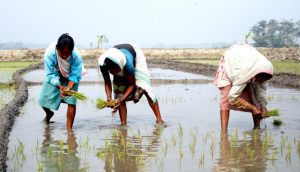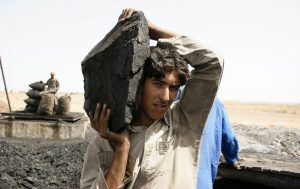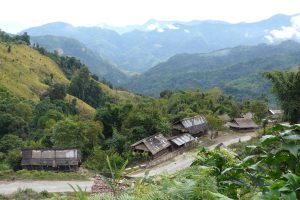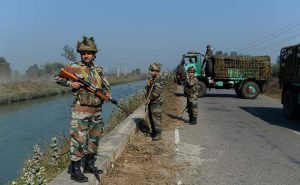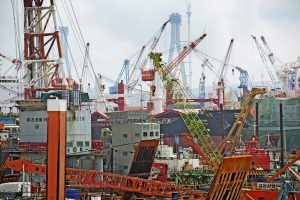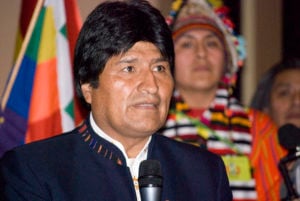See the first report in the series: USD 277.3 billion: India’s 2014 fossil fuel subsidy bill
See the second report in the series: Subsidies for poor are stolen by the rich
Between 1990 and 2012, India’s energy mix changed sharply, with coal becoming the dominant fuel. Traditional biomass — such as wood used in heating and cooking — lost share to coal, which increased to almost 45% in 2012, up from 33% in 1990.
There are three reasons why coal is a preferred energy source in India: Firstly it is cheap, secondly it is reliable, and thirdly India has 60.6 billion tonnes of coal deposits, although some of them are not accessible.
The biggest player in the coal market is the government. It owns a bit under 80% of Coal India Limited (CIL), the public sector mining company headquartered in Kolkata in eastern India. The largest coal producing corporate conglomerate in the world, CIL produces about 82% of the coal mined in India. This amount is set to increase dramatically, as India plans to more than double its coal output from 490 million tonnes to a billion tonnes by 2020, according to energy minister Piyush Goyal. He suggested that “the envisaged growth is possible in brown-field as well as green-field areas and is expected to be achieved through timely completion of new railway infrastructure projects, faster environment clearances and improvement in the law and order situation, apart from technology improvement in mining and related infrastructure.” This will need an investment of USD 20-25 billion.
Coal subsidies
The International Monetary Fund’s 2015 country profile places India’s post-tax subsidies on coal at USD 196 billion. The government also supports coal mining through research and development funds and several tax breaks to benefit exploration activities. The government also subsidises coal transport, mostly by the country’s nationalised railway network.
In emerging and developing Asia, coal subsidies accounted for USD 2 trillion (2.7% of global GDP or more than 40% of global post-tax subsidies) in 2013 and were predicted to have reached USD 2.5 trillion in 2015 (3.1% of global GDP or nearly 50% of global subsidies), with all its collateral damage to human health and the environment.
Oil and gas
Coal is, of course only a fraction of the problem. India also has 5.7 billion barrels of oil and 1.4 trillion cubic feet of gas, with considerable government “support” provided for oil and gas exploration. The capital outlay by the Ministry of Petroleum and Natural Gas, including the exploration and production of crude oil and natural gas, was USD 45.7 million in 2012.
Research conducted by the International Institute for Sustainable Development (IISD) reveals that in 2013 and 2014 as well, the capital outlay targeting the extraction and production of crude oil, natural gas, coal and the development of fossil-fuelled power projects constituted the largest share of India’s national subsidies to fossil fuel production, averaging around USD 64 million per year.
Perverse subsidies
The situation in the petroleum sector also indicates the perverse effect that subsidies can have. As explained in the first report in this series, up to 41% of the kerosene distributed is lost, possibly stolen, to be mixed with more expensive fuels, such as petrol or diesel. Kerosene, domestic LPG (liquefied petroleum gas) and diesel (until November 2014) were sold for less than international market prices with subsidies covering the gap.
However the entire deficit is not bridged by subsidies: a part of the difference between the cost price — including marketing costs — and the regulated selling prices of these three petroleum products is borne by the oil marketing companies (OMC). This is the difference between the cost price and the regulated price at which petroleum products are finally sold by the OMCs to the retailers. The rest of the difference is paid by the government to the OMCs as subsidy.
The oil ministry expects a subsidy burden of INR 50-60 billion (USD 788-946 million) for state-run oil and gas producers during the current fiscal year ending on March 31, 2016, if world oil prices stay at current levels.
The ministry has been changing the subsidy sharing formula between oil producers and the government. The new formula, following the changed subsidy mechanism for diesel and LPG in 2014 when the government freed diesel from subsidies and began paying LPG subsidies through direct benefit transfers (DBT), meant that the OMCs were only bearing a loss on account of selling subsidised kerosene.
This was supposed to spare the OMCs the burden of any subsidy costs if the crude oil price each quarter averaged less than USD 60 a barrel. Only when prices went beyond USD 60 a barrel were they to bear 85% of the incremental cost above USD 60, or 90% if oil price exceeded USD 100 a barrel. All these calculations have now become obsolete with international prices of crude oil collapsing below USD 30 a barrel mark in the last week of January 2016.
In July 2015, it was clear that the previous formula had been junked. The ministry of finance reportedly said that it would pay INR 12 in the form of cash subsidy for a litre of kerosene sold while the two large public sector domestic crude oil and gas explorers and producers, the Oil and Natural Gas Corporation (ONGC) and Oil India Limited (OIL) would bear the remaining burden. The actual subsidies given in 2014-15 to the two upstream oil companies, ONGC and OIL, cannot be clearly ascertained.
The problem is compounded by the clear overestimation of the government’s success rate with subsidy reductions. Having been hailed as the largest subsidy benefit transfer by the government, the LPG subsidy expenditure through DBT may not prove to be all that successful. On October 17 last year, an assessment based on an IISD report stated that the central government’s savings on LPG subsidy transfer were not more than INR 1.43 billion (USD 21 million) though it claimed INR 127 billion (USD 1.87 billion) in savings — a meagre 1.12% of the claimed amount.
In February 2015, the National Council of Applied Economic Research (NCAER) evaluated the costs and benefits of “pooling” (or averaging) the price of domestic and imported LPG or liquefied natural gas (LNG) for the power sector. It found that this will mean a price higher than the domestic price and an increase in the cost of production. Since the selling price of electricity has been administratively capped at INR 5.50 per kWh, the gap between the selling price and production cost would lead to a revenue shortfall for gas-based power plants.
New subsidies for gas
This shortfall is proposed to be partially borne by the government as subsidies and tax concessions, and partially by the interlinked sectors taking cuts in their revenues. Hence, the gas price pooling policy also includes a waiver of the 12.5% value added tax (VAT) and other levies on natural gas by the states, customs duty exemptions, a 50% cut in the pipeline tariff, a 50% cut in R-LNG (re-liquefied natural gas) re-gasification charges and a 75% cut in marketing margins by the government-owned Gas Authority of India Limited (GAIL), which is the designated gas pool operator.
Besides the direct and indirect subsidies given to producers and consumers of coal, oil and gas, the government of India provides subsidies to those who produce electricity using renewable sources — solar, wind and biogas. This is justified on the ground that these conserve the environment.
Apart from the size of the subsidy bill, the issue of merit subsidies — which provide an external benefit to society, such as the provision of education, environmental protection or the prevention of diseases — versus non-merit subsidies has been widely debated in India. A study conducted by the National Institute of Public Finance and Policy on the central government’s expenditure stated that non-merit subsidies at INR 672.5 billion (USD 9.9 billion) in 2003-04 accounted for 58% of the government’s total subsidy bill.
In effect, this meant that the government was subsidising what it should not — goods and services from which it could recover full user charges — and not subsidising what it should, things like basic and public health, sanitation, sewage treatment, roads and bridges. Technically speaking, subsidised LPG for all households can hardly qualify as a merit subsidy.
But non-merit subsidies such as the one on kerosene have huge political support that makes it difficult to remove them.
These issues will continue to be discussed and debated. There are clearly no simple or easy solutions to what are undoubtedly complex and contentious problems relating to ensuring that energy subsidies reach intended beneficiaries. Despite the views of economists, politics will prevail.
![<p>A coal-fired power plant in Chennai, hundreds of kilometres from the nearest coal mine [image by Prateek Rungta]</p>](https://dialogue.earth/content/uploads/2016/02/Fossil_Fuel_Subsidies_Story_3_Pic.jpg)
